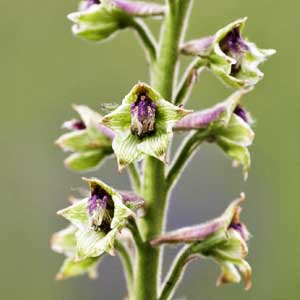Delphinium viridescens
Delphinium carolinianum
Wenatchee larkspur
Carolina larkspur
90-150 cm;
base usually green, glabrous.
(20-)40-90(-150) cm;
base reddish or not, ± pubescent.
blade cuneate to semicircular, 2-5 × 3-12 cm, nearly glabrous; ultimate lobes 3-21, width 1-8 mm.
blade round to pentagonal, 1-8 × 2-12 cm, pubescence variable; ultimate lobes 3-29, width 2-10 mm (basal), 1-7 mm (cauline).
25-80-flowered, dense;
pedicel 0.5-2 cm, glandular-pubescent;
bracteoles 1-4 mm from flowers, green, lanceolate, 3.5-6 mm, glandular-pubescent.
(3-)8-27(-94)-flowered;
pedicel (0.4-)0.7-1.8(-5.7) cm, nearly glabrous to glandular;
bracteoles 1-3.5(-6) mm from flowers, green or blue, linear, 2-7 mm, pubescence nearly glabrous to glandular.
sepals yellowish green, nearly glabrous, lateral sepals forward pointing, 7-9 × 3-4 mm, spurs decurved, 30-45° below horizontal, often hooked apically, 8-11 mm;
lower petal blades ± covering stamens, 4-6 mm, clefts 0.5-1.5 mm;
hairs centered, mostly near junction of blade and claw, yellow.
sepals purple to blue to white, nearly glabrous, lateral sepals spreading, (7-)9-14(-17) × (3-)3.5-6(-8) mm, spurs ± upcurved, ascending 20-90° above vertical, (9-)11-17(-19) mm;
lower petal blades ± covering stamens, 5-7 mm, cleft 2-4 mm;
hairs centered, densest near base of cleft, white, sometimes blue or yellow.
8-11 mm, 2.5-3 times longer than wide, puberulent.
(10-)12.5-18.5(-27) mm, 4-4.5 times longer than wide, glabrous to puberulent.
± wing-margined;
seed coat cells with surfaces ± roughened.
seed coat cells with surfaces pustulate or smooth.
Delphinium viridescens
Delphinium carolinianum
Of conservation concern.
Delphinium viridescens is local in mountains southwest of Wenatchee, Washington.
(Discussion copyrighted by Flora of North America; reprinted with permission.)
Subspecies 4 (4 in the flora).
(Discussion copyrighted by Flora of North America; reprinted with permission.)
1. Basal leaves absent at anthesis, cauline leaves divided into many narrow (less than 2 mm wide) segments, blade not distinctly 3-parted; distalmost petiole less than 5 mm; sepals usually blue or purple (rarely white). | subsp. carolinianum |
1. Basal leaves usually present at anthesis, and/or cauline leaf lobes usually wider than 2 mm, blade often distinctly 3-parted or more; distalmost petiole more than 5 mm; sepals blue or white. | → 2 |
2. Leaf blade distinctly 3-parted with few additional divisions; sepals blue to white; roots usually ± vertical, often without major branches. | subsp. vimineum |
2. Leaf blade with 3–5 or more major divisions, each further divided into segments; sepals white to very pale blue; roots ±horizontal with several major branches. | → 3 |
3. Stems usually less than 45 cm; in thin soils over limestone in clearings of deciduous woods; leaf blade with 3 major divisions; e of Mississippi River. | subsp. calciphilum |
3. Stems usually more than 45 cm; in deeper soils in grasslands; leaf blade with 5 or more major divisions; w of Mississippi River. | subsp. virescens |


